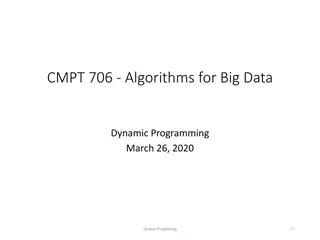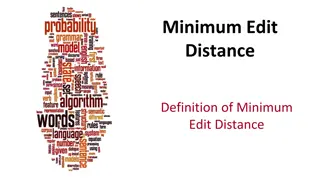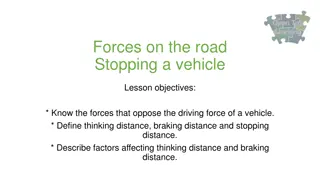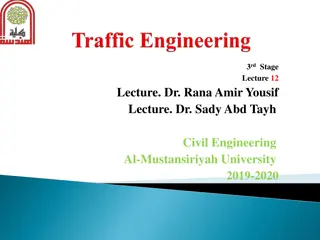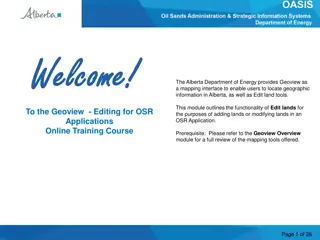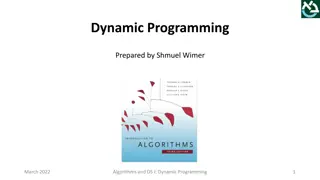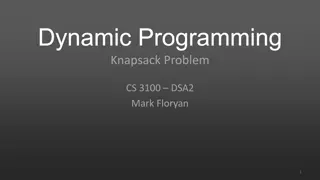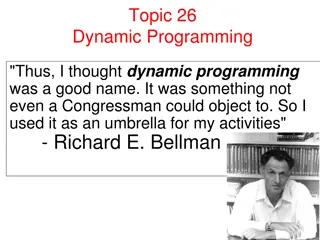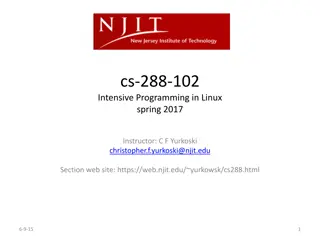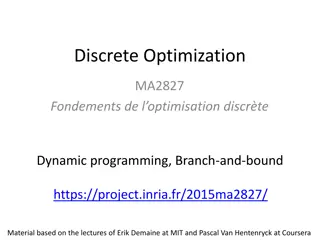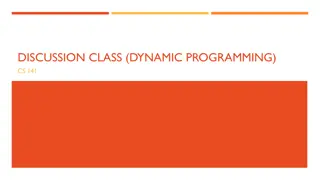Understanding Edit Distance and Dynamic Programming
Exploring the concept of edit distance in dynamic programming, focusing on finding the minimum number of deletions, insertions, and substitutions required to transform one string into another. The discussion includes examples, quick checks, recurrences, and the step-by-step process to simplify and solve the problem efficiently.
Download Presentation

Please find below an Image/Link to download the presentation.
The content on the website is provided AS IS for your information and personal use only. It may not be sold, licensed, or shared on other websites without obtaining consent from the author. Download presentation by click this link. If you encounter any issues during the download, it is possible that the publisher has removed the file from their server.
E N D
Presentation Transcript
Even More CSE 421 Fall 22 Lecture 13 Dynamic Programming
Edit Distance More formally: The edit distance between two strings is: The minimum number of deletions, insertions, transform string ? into string ?. deletions, insertions, and substitutions substitutions to Deletion: removing one character Insertion: inserting one character (at any point in the string) Substitution: replacing one character with one other.
Example What s the distance between babyyodas and tastysoda? B A B Y Y O D A S sub T sub S ins T sub S del A Y O D A Distance: 5, one point for each colored box Quick Checks can you explain these? If ? has length ? and ? has length ?, the edit distance is at most max(?,?) The distance from ? to ? is the same as from ? to ? (i.e. transforming ? to ? and ? to ? are the same)
Finding a recurrence What information would let us simplify the problem? What would let us take one step toward the solution? Handling one character of ? or ? i.e. choosing one of insert, delete, or substitution and increasing the distance by 1 OR realizing the characters are the same and matching for free. ???(?,?) is the minimum number of insertions, deletions, and substitutions to transform ?1?2 ?? into ?1?2 ??. (we re indexing strings from 1, it ll make things a little prettier).
The recurrence Handling one character of ? or ? i.e. choosing one of insert, delete, or substitution and increasing the distance by 1 OR realizing the characters are the same and matching for free. What does delete look like? ???(? 1,?) (delete character from ? match the rest) Insert ???(?,? 1) Substitution: ???(? 1,? 1) Matching charcters? Also ???(? 1,? 1) but only if ??= ??
The recurrence (v1, well improve soon) Handling one character of ? or ? i.e. choosing one of insert, delete, or substitution and increasing the distance by 1 OR realizing the characters are the same and matching for free. Substitution Delete Insert TODO: Just Match ??? ?,? = min 1 + ??? ? 1,? ,1 + ??? ?,? 1 , 1 + ??? ? 1,? 1 ,??? ? 1,? 1 + ?{?? ??} ? ? if ? = 0 if ? = 0
The recurrence (v1, well improve soon) Handling one character of ? or ? i.e. choosing one of insert, delete, or substitution and increasing the distance by 1 OR realizing the characters are the same and matching for free. Substitution Just Match Delete Insert ??? ?,? = min 1 + ??? ? 1,? ,1 + ??? ?,? 1 , 1 + ??? ? 1,? 1 ,??? ? 1,? 1 + ?{?? ??} ? ? Idea: only allow just match when you can just match. Otherwise make it (will never be the min). In code: if/else branch, probably. This is a math notation trick. if ? = 0 if ? = 0 Indicator like from 312
The recurrence Handling one character of ? or ? i.e. choosing one of insert, delete, or substitution and increasing the distance by 1 OR realizing the characters are the same and matching for free. Insert Delete Sub and matching min 1 + ??? ? 1,? ,1 + ??? ?,? 1 , ?[?? ??] + ??? ? 1,? 1 ? ? ??? ?,? = if ? = 0 if ? = 0 When we could match, we will never substitute; matching will always give us a better score! Still have to check delete, insert (those could be better).
The recurrence Handling one character of ? or ? i.e. choosing one of insert, delete, or substitution and increasing the distance by 1 OR realizing the characters are the same and matching for free. Insert Delete Sub and matching min 1 + ??? ? 1,? ,1 + ??? ?,? 1 , ?[?? ??] + ??? ? 1,? 1 ? ? ??? ?,? = if ? = 0 if ? = 0
Edit Distance ???(?,?)0 0 0 0 T 1 T 1 A 2 A 2 S 3 S 3 T 4 T 4 Y 5 Y 5 S 6 S 6 O 7 O 7 D 8 D 8 A 9 A 9 B, 1 B, 1 A, 2 A, 2 B, 3 B, 3 Y, 4 Y, 4 Y, 5 Y, 5 O, 6 O, 6 D, 7 D, 7 A, 8 A, 8 S, 9 S, 9
Edit Distance ???(?,?)0 0 0 0 T 1 T 1 1 A 2 A 2 2 S 3 S 3 3 T 4 T 4 4 Y 5 Y 5 5 S 6 S 6 6 O 7 O 7 7 D 8 D 8 8 A 9 A 9 9 B, 1 B, 1 1 A, 2 A, 2 2 B, 3 B, 3 3 Y, 4 Y, 4 4 Y, 5 Y, 5 5 O, 6 O, 6 6 D, 7 D, 7 7 A, 8 A, 8 8 S, 9 S, 9 9 0
Current subproblem: edit dist between BABY and TAS Y B T A A B S Edit Distance ???(?,?)0 0 0 0 T 1 T 1 1 A 2 A 2 2 S 3 S 3 3 T 4 T 4 4 Y 5 Y 5 5 S 6 S 6 6 O 7 O 7 7 D 8 D 8 8 A 9 A 9 9 B, 1 B, 1 1 A, 2 A, 2 2 B, 3 B, 3 3 Y, 4 Y, 4 4 Y, 5 Y, 5 5 O, 6 O, 6 6 D, 7 D, 7 7 A, 8 A, 8 8 S, 9 S, 9 9 0
Delete: get rid of Y (cost 1) BAB TAS Y B T A A B S Edit Distance ???(?,?)0 0 0 0 T 1 T 1 1 A 2 A 2 2 S 3 S 3 3 T 4 T 4 4 Y 5 Y 5 5 S 6 S 6 6 O 7 O 7 7 D 8 D 8 8 A 9 A 9 9 B, 1 B, 1 1 A, 2 A, 2 2 B, 3 B, 3 3 Y, 4 Y, 4 4 Y, 5 Y, 5 5 O, 6 O, 6 6 D, 7 D, 7 7 A, 8 A, 8 8 S, 9 S, 9 9 0
Insert: insert S (cost 1) BABY TA Y B T A A B S Edit Distance ???(?,?)0 0 0 0 T 1 T 1 1 A 2 A 2 2 S 3 S 3 3 T 4 T 4 4 Y 5 Y 5 5 S 6 S 6 6 O 7 O 7 7 D 8 D 8 8 A 9 A 9 9 B, 1 B, 1 1 A, 2 A, 2 2 B, 3 B, 3 3 Y, 4 Y, 4 4 Y, 5 Y, 5 5 O, 6 O, 6 6 D, 7 D, 7 7 A, 8 A, 8 8 S, 9 S, 9 9 0
Sub: Transform Y to S (cost 1) BAB TA Y B T A A B S Edit Distance ???(?,?)0 0 0 0 T 1 T 1 1 A 2 A 2 2 S 3 S 3 3 T 4 T 4 4 Y 5 Y 5 5 S 6 S 6 6 O 7 O 7 7 D 8 D 8 8 A 9 A 9 9 B, 1 B, 1 1 A, 2 A, 2 2 B, 3 B, 3 3 Y, 4 Y, 4 4 Y, 5 Y, 5 5 O, 6 O, 6 6 D, 7 D, 7 7 A, 8 A, 8 8 S, 9 S, 9 9 0
Gold entry will be min of: 1 + delete 1 + insert 1 + sub Y B T A A B S Edit Distance ???(?,?)0 0 0 0 T 1 T 1 1 A 2 A 2 2 S 3 S 3 3 T 4 T 4 4 Y 5 Y 5 5 S 6 S 6 6 O 7 O 7 7 D 8 D 8 8 A 9 A 9 9 B, 1 B, 1 1 A, 2 A, 2 2 B, 3 B, 3 3 Y, 4 Y, 4 4 Y, 5 Y, 5 5 O, 6 O, 6 6 D, 7 D, 7 7 A, 8 A, 8 8 S, 9 S, 9 9 0
Gold entry will be min of: 1 + delete 1 + insert 1 + sub 1 + 2 1 + 3 1 + 2 Min: 3 Edit Distance ???(?,?)0 0 0 0 T 1 T 1 1 A 2 A 2 2 S 3 S 3 3 T 4 T 4 4 Y 5 Y 5 5 S 6 S 6 O 7 O 7 D 8 D 8 A 9 A 9 B, 1 B, 1 1 1 2 3 4 5 A, 2 A, 2 2 2 1 2 3 4 B, 3 B, 3 3 3 2 2 3 4 Y, 4 Y, 4 4 4 3 3 3 3 Y, 5 Y, 5 5 5 4 4 4 O, 6 O, 6 6 6 5 5 5 D, 7 D, 7 7 7 6 6 6 A, 8 A, 8 8 8 7 7 7 S, 9 S, 9 9 9 8 7 8 0
Edit Distance Fill in the next two entries. Be careful with the sub/match distinction! ???(?,?)0 0 0 0 T 1 T 1 1 A 2 A 2 2 S 3 S 3 3 T 4 T 4 4 Y 5 Y 5 5 S 6 S 6 O 7 O 7 D 8 D 8 A 9 A 9 B, 1 B, 1 1 1 2 3 4 5 A, 2 A, 2 2 2 1 2 3 4 B, 3 B, 3 3 3 2 2 3 4 Y, 4 Y, 4 4 4 3 3 3 3 Y, 5 Y, 5 5 5 4 4 4 O, 6 O, 6 6 6 5 5 5 D, 7 D, 7 7 7 6 6 6 A, 8 A, 8 8 8 7 7 7 S, 9 S, 9 9 9 8 7 8 0
Edit Distance Fill in the next two entries. Be careful with the sub/match distinction! ???(?,?)0 0 0 0 T 1 T 1 1 A 2 A 2 2 S 3 S 3 3 T 4 T 4 4 Y 5 Y 5 5 S 6 S 6 O 7 O 7 D 8 D 8 A 9 A 9 B, 1 B, 1 1 1 2 3 4 5 A, 2 A, 2 2 2 1 2 3 4 B, 3 B, 3 3 3 2 2 3 4 Y, 4 Y, 4 4 4 3 3 3 3 Y s match, so sub is free! Y, 5 Y, 5 5 5 4 4 4 3 3 O, 6 O, 6 6 6 5 5 5 4 4 D, 7 D, 7 7 7 6 6 6 A, 8 A, 8 8 8 7 7 7 S, 9 S, 9 9 9 8 7 8 0
Edit Distance ???(?,?)0 0 0 0 T 1 T 1 1 A 2 A 2 2 S 3 S 3 3 T 4 T 4 4 Y 5 Y 5 5 S 6 S 6 6 O 7 O 7 7 D 8 D 8 8 A 9 A 9 9 B, 1 B, 1 1 1 2 3 4 5 6 7 8 9 A, 2 A, 2 2 2 1 2 3 4 5 6 7 8 B, 3 B, 3 3 3 2 2 3 4 5 6 7 8 Y, 4 Y, 4 4 4 3 3 3 3 4 5 6 7 Y, 5 Y, 5 5 5 4 4 4 3 4 5 6 7 O, 6 O, 6 6 6 5 5 5 4 4 4 5 6 D, 7 D, 7 7 7 6 6 6 5 5 5 4 6 A, 8 A, 8 8 8 7 7 7 6 6 6 5 4 S, 9 S, 9 9 9 8 7 8 7 6 7 6 5 0
Edit Distance what operations? ???(?,?)0 0 0 0 T 1 T 1 1 A 2 A 2 2 S 3 S 3 3 T 4 T 4 4 Y 5 Y 5 5 S 6 S 6 6 O 7 O 7 7 D 8 D 8 8 A 9 A 9 9 B, 1 B, 1 1 1 2 3 4 5 6 7 8 9 A, 2 A, 2 2 2 1 2 3 4 5 6 7 8 B, 3 B, 3 3 3 2 2 3 4 5 6 7 8 Y, 4 Y, 4 4 4 3 3 3 3 4 5 6 7 Y, 5 Y, 5 5 5 4 4 4 3 4 5 6 7 O, 6 O, 6 6 6 5 5 5 4 4 4 5 6 D, 7 D, 7 7 7 6 6 6 5 5 5 4 6 A, 8 A, 8 8 8 7 7 7 6 6 6 5 4 S, 9 S, 9 9 9 8 7 8 7 6 7 6 5 0
Edit Distance what operations? ???(?,?)0 0 0 0 T 1 T 1 1 A 2 A 2 2 S 3 S 3 3 T 4 T 4 4 Y 5 Y 5 5 S 6 S 6 6 O 7 O 7 7 D 8 D 8 8 A 9 A 9 9 B, 1 B, 1 1 1 2 3 4 5 6 7 8 9 A, 2 A, 2 2 2 1 2 3 4 5 6 7 8 B, 3 B, 3 3 3 2 2 3 4 5 6 7 8 Y, 4 Y, 4 4 4 3 3 3 3 4 5 6 7 Y, 5 Y, 5 5 5 4 4 4 3 4 5 6 7 O, 6 O, 6 6 6 5 5 5 4 4 4 5 6 D, 7 D, 7 7 7 6 6 6 5 5 5 4 6 A, 8 A, 8 8 8 7 7 7 6 6 6 5 4 S, 9 S, 9 9 9 8 7 8 7 6 7 6 5 0
Dynamic Programming Process 1. Define the object you re looking for ???(?,?) is the minimum number of insertions, deletions, and substitutions to transform ?1?2 ?? into ?1?2 ??. 2. Write a recurrence to say how to find it 3. Design a memoization structure ? ? Array 4. Write an iterative algorithm Outer loop: increasing ? (starting from 1) Inner loop: increasing ? (starting from 1)
DP Proofs We generally won t programming problems. Why? Why? The proofs are always inductive proofs where you say my recurrence checks all the possibilities or, equivalently The maximum thing has to be made up of the best thing for all these other subproblems. The proof itself is very difficult to write clearly (you have to differentiate between your recurrence and what your recurrence intends to calculate, which can be won t ask you for proofs of correctness on dynamic
DP Proofs We ll include an example proof sometime in the next few week so you know what you re (not) missing. Instead, we re going to ask for your intuition on what your recurrence is doing (what do all the cases correspond to/why are they exhaustive)? The proof is just a lot of formalism on that key idea. So we re going to have you focus on the idea, not the formalism.
Goal of DP Just try all the (reasonable) possibilities. Don t worry about greedily choosing the best, use recursion to look ahead for all the best options, and pick the best one. There is a greedy-ish alteration to the Edit Distance recurrence It turns out, if the two characters match, that will always be at least as good as the insert/delete options. But it s fine to not not notice! And if you thought it was safe but wasn t, well .
Maximum Contiguous Subarray Sum We saw an ?(?log?) divide and conquer algorithm. Can we do better with DP? Given: Array ?[] Output: ?,? such that ? ? + ? ? + 1 + + ?[?] is maximized.
Dynamic Programming Process 1. Define the object you re looking for 2. Write a recurrence to say how to find it 3. Design a memoization structure 4. Write an iterative algorithm
Maximum Contiguous Subarray Sum We saw an ?(?log?) divide and conquer algorithm. Can we do better with DP? Given: Array ?[] Output: ?,? such that ? ? + ? ? + 1 + + ?[?] is maximized. For today: just output the value? ? + ? ? + 1 + + ?[?]. Is it enough to know OPT(i)?
Trying to Recurse 0 0 5 1 1 -6 2 2 3 3 3 4 4 4 -5 5 5 2 6 6 2 7 7 4 ??? 3 would give ? =2, ? = 3 ???(4) would give ? = 2,? = 3 too ???(7) would give ? = 2,? = 7 we need to suddenly backfill with a bunch of elements that weren t optimal How do we make a decision on index 7? What information do we need?
What do we need for recursion? If index ? IS going to be included We need the best subarray that includes index that includes index ? ? If we include anything to the left, we ll definitely include index ? 1 (because of the contiguous requirement) If index ?isn t included We need the best subarray up to ? 1, regardless of whether ? 1 is included.
Two Values Pollev.com/robbie Need two recursive values: ???????(?): sum of the maximum sum subarray among elements from 0 to ? that includes index that includes index ? in the sum ???(?): sum of the maximum sum subarray among elements 0 to ? (that might or might not include ?) How can you calculate these values? Try to write recurrence(s), then think about memoization and running time.
Recurrences max ? ? ,? ? + ??????? ? 1 if ? 0 otherwise ??????? ? = 0 ??? ? = max ??????? ? ,??? ? 1 if ? 0 0 otherwise If we include ?, the subarray must be either just ? or also include ? 1. Overall, we might or might not include ?. If we don t include ?, we only have access to elements ? 1 and before. If we do, we want ???????(?) by definition.
Example 0 0 5 1 1 2 2 3 3 3 4 4 4 -5 5 5 2 6 6 2 7 7 4 ? -6 0 0 5 1 1 2 2 3 3 4 4 5 5 6 6 7 7 ???(?) 0 0 5 1 1 2 2 3 3 4 4 5 5 6 6 7 7 ???????(?)
Example 0 0 5 1 1 2 2 3 3 3 4 4 4 -5 5 5 2 6 6 2 7 7 4 ? -6 0 0 5 1 1 5 2 2 3 3 4 4 5 5 6 6 7 7 ???(?) 0 0 5 1 1 -1 2 2 3 3 4 4 5 5 6 6 7 7 ???????(?)
Example 0 0 5 1 1 2 2 3 3 3 4 4 4 -5 5 5 2 6 6 2 7 7 4 ? -6 0 0 5 1 1 5 2 2 5 3 3 7 4 4 7 5 5 7 6 6 7 7 7 10 ???(?) 0 0 5 1 1 -1 2 2 3 3 3 7 4 4 2 5 5 4 6 6 6 7 7 10 ???????(?)
Pseudocode int maxSubarraySum(int[] A) int n=A.length int[] OPT = new int[n] int[] Inc = new int[n] inc[0]=A[0]; OPT[0] = max{A[0],0} for(int i=0;i<n;i++) inc[i]=max{A[i], A[i]+inc[i-1]} OPT[i]=max{inc[i], opt[i-1]} endFor return OPT[n-1]
Recursive Thinking In General As before, the hardest part is designing the recurrence. It sometimes helps to think from multiple different angles. Top Top- -down: down: What s the first step to take? Baby Yoda will first go left or down. Use recursion to find out which of left or down is better. The farthest right operation in the string transformation will be one of insert, delete, substitute, match for free. Use recursion to find out which is best.
Recursive Thinking In General Bottom Bottom- -Up: help? How does a path through most of the map help Baby Yoda? Well we just need to know the values one left and one down. The edit distance between which strings would help us compute the edit distance between our strings? Well if we know the distance between ?1 ?? 1 and ?1 ?? 1 then that would tell us what happens if we substitute that might lead you to insertions and deletions too. Up: What information could a recursive call give me that would
Recursive Thinking In General Some people refer to the Optimal Substructure Property From the optimum (most eggs, fewest number of string operations) for a slightly smaller problem (Baby Yoda starting closer to the end, slightly smaller strings), we need to be able to build up the optimum for the full problem.
Longest Increasing Subsequence 0 5 1 2 3 3 6 4 5 2 6 8 7 -6 -5 10 Longest set of (not necessarily consecutive) elements that are increasing 5 is optimal for the array above (indices 1,2,3,6,7; elements 6,3,6,8,10) For simplicity assume all array elements are distinct.


